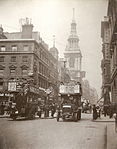All Hallows Honey Lane
12th-century church buildings in England1666 disestablishments in EnglandChurches destroyed in the Great Fire of London and not rebuiltChurches in the City of LondonFormer buildings and structures in the City of London ... and 1 more
Pages containing links to subscription-only content

All Hallows, Honey Lane was a parish church in the City of London, England. Of medieval origin, it was destroyed in the Great Fire of London in 1666 and not rebuilt; the site became part of Honey Lane Market, which was in turn partially cleared to make way for the City of London School in the 19th century. Much of the area was destroyed during the bombing in World War II and has been redeveloped. The name Honey Lane is retained in a nearby walkway.
Excerpt from the Wikipedia article All Hallows Honey Lane (License: CC BY-SA 3.0, Authors, Images).All Hallows Honey Lane
Russia Row, City of London
Geographical coordinates (GPS) Address Nearby Places Show on map
Geographical coordinates (GPS)
| Latitude | Longitude |
|---|---|
| N 51.5145 ° | E -0.0935 ° |
Address
PizzaExpress
Russia Row 8
EC2V 8BL City of London
England, United Kingdom
Open on Google Maps











